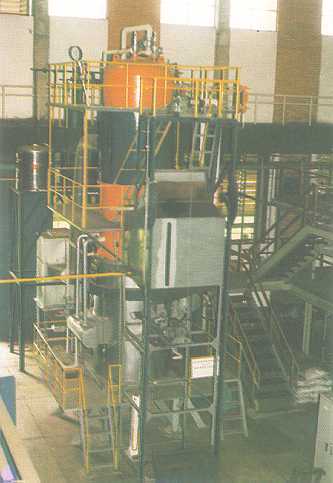In order to burn those fuels with several operating conditions, a 1.5 ton/h of fluidized bed boiler has been constructed at Energy Technology Laboratory (UPT-LSDE), BPP Teknologi, PUSPIPTEK, Serpong since the end of 1994. The figure below shows an Atmospheric Bubbling Fluidized Bed Boiler in LSDE's laboratory.
The unit is 6 m high and supported by I-Beam
steel structure at the base. The diameter of combustion chamber is 0.8
m (i.d) consisting of oil atomizer for start-up, water tube, bubble cap
distributor, plenum chamber and ash discharge pipe. In the combustion process,
fule is fed to the fluidized bed consisting of inert material of sand (bed
depth~25 cm). For solid fuels such as coal, the fuel content of the bed
is between 5-10 %. The hot bed particles acts as a heat reservoir and stabilize
teh combustion process, making the fluidized bed a very desirable device
for burning low-grade coals and waste materials.

<=Back Next=>
The superficial velocity of the air through the bed is around 1 m/s (adjustable through a damper) at a bed temperature 750-950 0C. A secondary air as a staged combustion is also introduced in the perimeter of the middle freeboard.
The products of combustion leaving the bed contain a large portion of unburned carbon particles that are collected in a multi-cyclone separator, which seperates these particles from the gas by imparting a centrifugal acceleration by means of an induced darft fan (I.D.F) on the mixture.
Heat is extracted through the furnace wall by boiler water tubes. The production of steam is approximately 1,500 kg/hr at 9.5 bar,~1800C and will be fed to a steam turbine for power generation (~40 kWe)in the near future. Emission of CO2, CO, SO2 and NOx is monitor by portable gas analizer.
Thermocouples are located at point of concern for combustion studies such as the freeboard, boiler entry, boiler exit, in-bed, and cycloneentry and outlet temperature.
Three control strategies were employed by
the system, namely bed temperature, steam flowrate, and freeboard control
strategies, so to ensure the maximum combustion efficiency and the safety
operation can be maintain.